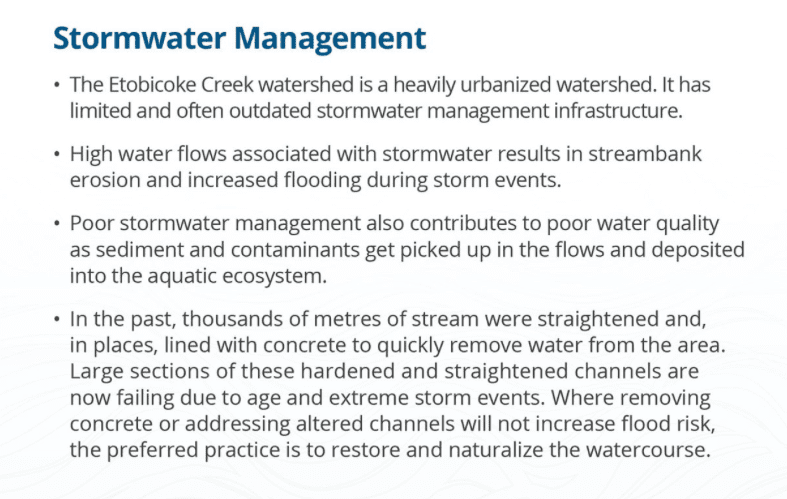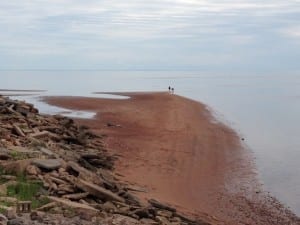Toronto and Region Conservation has issued eleven Report Cards for watersheds under its jurisdiction.
Click here to access the 2018 TRCA Report Card for Etobicoke Creek >
Click here to access the other TRCA 2018 Watershed Report Cards >
Click here for previous posts at Preserved Stories website regarding Etobicoke Creek >
Below is a screenshot of text from the 2018 TRCA Report Card for Etobicoke Creek
Commentary
In the postwar era, straightening of creeks was the standard approach, as a study of the postwar history of Etobicoke Creek, which I have documented in a small way at this website, attests.
The story, from the 2018 TRCA Report Card for Etobicoke Creek, of the currently deteriorating concrete structures, that were set into place in an effort to channelize the remaining (eastern) branch of Etobicoke Creek, in the postwar years, is of interest.
A key part of the story is that the channelizing, a particular attempt to engineer a stream, was part of an effort to address the consequences of the efforts beginning in 1929, to engineer the mouth of Etobicoke Creek, in order to allow for the western extension of Lake Promenade, during the Cottage Country era at the creek’s floodplain.
The subtext, of such a standard approach, was: “With modern engineering, we can do anything we want; with modern engineering, we can vastly improve upon, what nature has provided for us.”
I am pleased that such an approach is no longer in practice as it applies, at least, to the channelizing of rivers and streams.
I am also pleased that naturalization is proceeding full-speed ahead at the Lakeview Waterfront Connection project. Such a form of naturalization celebrates engineering in service of (as opposed to engineering, seeking to exert dominance over) the natural environment.
The goal is to create new wetlands along the Lakeview stretch of the Lake Ontario waterfront. What is also inspiring is that the entire Lakevew project is community-driven – an instance where the reality of civic engagement is, indeed, congruent with the associated rhetoric. Credit Valley Conservation is a key player in the exemplary Lakeview initiative.
History of the engineering – ‘out of existence’ – of what was once a major wildlife habitat, at the mouth of Etobicoke Creek
The following post features a handy little map showing Etobicoke Creek before and after it was channelized:
Here’s a quick view of Marie Curtis Park, before and after the creek was channelized
As I understand, the engineering of Etobicoke Creek began in 1929:
If we go further back in history, we get a sense of the natural grandeur that was in place, over many centuries at the mouth of Etobicoke Creek, before twentieth-century engineering wiped it out of existence:
Update
The relationship between the human world and the world of nature, addressed at this post, brings to mind a recent study entitled:
L.M. Montgomery and the Matter of Nature(s) (2018)
A blurb, at the Toronto Public Library website, for the latter study reads (I have broken the text into shorter segments, for ease of online reading):
L.M. Montgomery’s writings are replete with enchanting, yet subtle and fluid depictions of nature that convey her intense appreciation for the natural world. At a time of ecological crises, intensifying environmental anxiety, and burgeoning eco-critical perspectives, L.M. Montgomery and the Matter of Nature(s) repositions the Canadian author’s relationship to nature in terms of current environmental criticism across several disciplines, introducing a fresh approach to her life and work.
Drawing on a wide range of Montgomery’s novels as well as her journals, this collection suggests that socio-ecological relationships encompass ideas of reciprocity, affiliation, autonomy, and the capacity for transformation in both the human and more-than-human worlds, and that these ideas are integral to Montgomery’s vision and her literary legacy.
Framed by the twin themes of materiality and interrelationships, essays by scholars of literature, law, animal studies, anthropology, and ecology examine place, embodiment, and difference in Montgomery’s works and embrace the multiplicities embedded in the concept of nature. Through innovative critical approaches, L.M. Montgomery and the Matter of Nature(s) opens up conversations about humans’ interactions with nature and the material environment.
[End]
Some years ago, I visited Prince Edward Island with my family, and was very pleased to get acquainted with the buildings, now functioning as a museum, which played a key role in Lucy Maud Montgomery’s life on the island.
In years past, I’ve also enjoyed getting to know about Lucy Montgomery Park, which is part of Montgomery’s legacy from a later stage in the author’s life after she had settled in Toronto.


